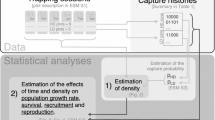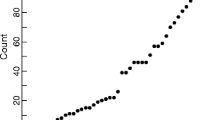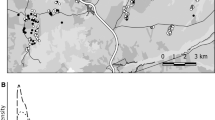Abstract
Microtus duodecimcostatus in a mediterranean vole which is not known to display spectacular increases in population numbers as in some microtine species. A population was studied in southern France with a capture-recapture method. The population included resident adults which have a high and constant survival rate (monthly estimate: 0.879), erratic adults (those caught once only), and juveniles which have a lower and constant survival rate. The adult survival rate was not sexbiased but the juvenile survival rate was higher in males (monthly estimates: 0.710 and 0.596 for males and females, respectively). Adult body weight did not vary seasonally. Residents had a higher mean body weight than erratics. Reproduction occurred all the year round. The proportion of reproductive females was higher among residents than among erratics. Population numbers varied seasonally. Our study points out thatM. duodecimcostatus is very different from microtine species which display cyclic fluctuations. Population studies on the subgenusPitymys (which containsM. duodecimcostatus and its closest related species) suggest that they are typically non-cyclic. The importance of social factors in the control of reproduction and maturation was evidenced inM. pinetorum. The role of such factors in the population regulation ofM. duodecimcostatus is discussed.
Similar content being viewed by others
References
Abramsky Z, Tracy R (1979) Population biology of a “noncycling” population of prairie voles and a hypothesis on the role of migration in regulating microtine cycles Ecology 60: 349–361
Agrell J, Erlinge S, Nelson J, Sandell M (1992) Body weight and population dynamics: cyclic demography in a noncyclic population of the field vole (Microtus agrestis). Can J Zool 70: 494–501
Beacham TD (1980) Survival of cohorts in a fluctuating population of the voleMicrotus townsendii. J Zool (Lond) 191: 49–60
Begon M (1983) Abuses of mathematical techniques in ecology: applications of Jolly's capture-recapture method. Oikos 40: 155–158
Boonstra R (1977) Effects of conspecifics on survival during population declines inMicrotus townsendii. J Anim Ecol 46: 835–851
Boonstra R (1985) Demography ofMicrotus pennsylvanicus in southern Ontario: enumeration versus Jolly-Seber estimation compared. Can J Zool 63: 1174–1180
Boonstra R (1989) Life history variation in maturation in fluctuating meadow vole populations (Microtus pennsylvanicus). Oikos 54: 265–274
Boonstra R, Boag PT (1987) A test of the Chitty hypothesis: inheritance of life-history traits in meadow volesMicrotus pennsylvanicus. Evolution 41: 929–947
Boonstra R, Krebs CJ, Gaines MS, Johnson ML, Craine ITM (1987) Natal philopatry and breeding systems in voles (Microtus spp.). J Anim Ecol 56: 655–673
Bujalska G (1970) Reproduction stabilizing elements in an island population ofClethrionomys glareolus (Schreber 1780). Acta Theriol 15: 381–412
Burns GR (1981) Population dynamics of island populations of subarcticClethrionomys rutilus. Can J Zool 59: 2115–2122
Chitty D (1967) The natural selection of self-regulatory behaviour in animal populations. Proc Ecol Soc Aust 2: 51–78
Cockburn A, Lidicker WZ Jr (1983) Microhabitat heterogeneity and population ecology of herbivorous rodent,Microtus californicus. Oecologia 59: 167–177
Cohen-Shlagman L Yom-Tov Y, Hellwing S (1984) The biology of the Levant vole,Microtus guentheri in Israel. I. Population dynamics in the field. Z Säugetierk 49: 135–147
Cornbower TR, Kirkland GL Jr (1983) Comparisons of pine vole (Pitymys pinetorum) populations from orchards and natural habitats in south central Pennsylvania. Proc Pa Acad Sci 57: 147–154
Delattre P, Giraudoux P, Baudry J, Musard P, Toussaint M, Truchetet D, Stahl P, Lazarine Poule M, Artois M, Damange J-P, Quéré J-P (1992) Land use patterns and types of common volc (Microutus arvalis) population kinetics. Agric Ecosyst Environ 39: 153–169
Efford M (1992) Comment-Revised estimates of the bias in the ‘minimum number alive’ estimator. Can J Zool 70: 628–631
Elton CS (1942) Voles, mice and lemmings. Clarendon Press, Oxford
Erlinge S, Göransson G, Hansson L, Högstedt G, Liberg O, Nilsson IN, Nilsson T, Schantz TV, Sylvén M (1983) Predation as a regulating factor on small rodent populations in southern Sweden. Oikos 40: 36–52
Erlinge S, Göransson G, Högstedt G, Jansson G, Liberg O, Loman J, Nilsson IN, Schantz TV, Sylvén M (1984) Can vertebrate predators regulate their prey? Am Nat 123: 125–133
Erlinge S, Göransson G, Högstedt G, Jansson G, Liberg O, Loman J, Nilsson IN, Schantz TV, Sylvén M (1988) More thoughts on vertebrate predator regulation of prey. Am Nat 132 148–154
Fuller WA (1977) Demography of a subarctic population ofClethrionomys gapperi: numbers and survival. Can J Zool 55: 42–51
Garsd A, Howard WE (1982) Microtine population fluctuation: an ecosystem approach based on time-series analysis. J Anim Ecol 51: 225–234
Getz LL, Hofmann JE, Klatt BJ, Verner L, Cole FR, Lindroth RL (1987) Fourteen years of population fluctuations ofMicrotus ochrogaster andM. pennsylvanicus in east central Illinois. Can J Zool 65: 1317–1325
Gilbert BS, Krebs CJ (1991) Population dynamics ofClethrionomys andPeromyscus in southwestern Yukon 1973–1989. Holarct Ecol 14: 250–259
Gliwicz J (1989) Individuals and populations of the bank vole in optimal, suboptimal and insular habitats. J Anim Ecol 58: 237–247
Greenwood PJ (1980) Mating systems, philopatry and dispersal in birds and mammals. Anim Behav 28: 1140–1162
Guédon G, Pascal M, Mazouin F (1991) Le campagnol provençal en captivité (Pitymys duodecimcostatus de Sélys-Longchamps, 1839) (Rongeurs, Microtidés) I. La reproduction. Mammalia 55: 97–106
Guédon G, Paradis E, Croset H (1992) Capture-recapture study of a population of the mediterranean pine vole (Microtus duodecimcostatus) in southern France. Z Säugetier 57: 364–372
Hanski I, Hansson L, Henttonen H (1991) Specialis predators, generalist predators, and the microtine cycle. J Anim Ecol 60: 353–367
Hansson L (1984a) Predation as the factor causing extended low densities in microtine cycles. Oikos 43: 255–256
Hansson L (1984b) Composition of cyclic and non-cyclic vole populations: on the causes of variation in individual quality amongClethrionomys glareolus in Sweden. Oecologia 63: 199–206
Hansson L (1988) Parent-offspring correlations for growth and reproduction in the voleClethrionomys glareolus in relation to the Chitty Hypothesis. Z Säugetierk 53: 7–10
Hansson L (1992) Fitness and life history correlates of weight variations in small mammals. Oikos 64: 479–484
Hansson L, Henttonen H (1985) Gradients in density variations of small rodents: the importance of latitude and snow cover. Oecologia 67: 394–402
Hansson L, Henttonen H (1988) Rodent dynamics as community processes. Trends Ecol Evol 3: 195–200
Henttonen H (1985) Predation causing extended low densities in microtine cycles: further evidence from shrew dynamics. Oikos 45: 156–157
Henttonen H, McGuire AD, Hansson L (1985) Comparisons of amplitude and frequencies (spectral analysis) of density variations in long-term data sets ofClethrionomys species. Ann Zool Fenn 22: 221–227
Hörnfeldt B (1991) Cycles of voles, predators, and alternative prey in boreal Sweden. PhD dissertation, University of Umeå
Keller BL (1985) Reproductive patterns. In: Tamarin RH (ed) Biology of New WorldMicrotus. Spec Publ Am Soc Mammal 8: 725–778
Korpimäki E, Norrdahl K, Rinta-Jaskari T (1991) Responses of stoats and least weasels to fluctuating food abundances: is the low phase of the vole cycle due to mustelid predation? Oecologia 88: 552–561
Krebs CJ (1979) Dispersal, spacing behaviour, and genetics in relation to population fluctuations in the voleMicrotus townsendii. Fortschr Zool 25: 61–77
Krebs CJ, Myers JH (1974) Population cycles in small mammals. Adv Ecol Res 8: 267–399
Krebs CJ, Keller BL, Tamarin RH (1969)Microtus population biology: demographic changes in fluctuating populations ofM. ochrogaster andM. pennsylvanicus in southern Indiana. Ecology 50: 587–607
Lebreton JD, Burnham KP, Clobert J, Anderson DR (1992) Modeling survival and testing biological hypotheses using marked animals: a unified approach with case studies. Ecol Monogr 62: 67–118
Lefebvre LW, Otis DL, Holler NR (1982) Comparison of open and closed models for cotton rat population estimates. J Wildl Manage 46: 156–163
Lidicker WZ Jr (1973) Regulation of numbers in an island population of the California vole, a problem in community dynamics. Ecol Monogr 43: 271–302
Lidicker WZ Jr (1985) Population structuring as a factor in understanding microtine cycles. Acta Zool Fenn 173: 23–27
Lidicker WZ Jr, Ostfeld RS (1991) Extra-large body size in California voles: causes and fitness consequences. Oikos 61: 108–121
Menkens GE Jr., Anderson SH (1988) Estimation of small-mammal population size. Ecology 69: 1952–1959
Mihok S, Turner BN, Iverson SL (1985) The characterization of vole population dynamics. Ecol Monogr 55: 399–420
Miller DH, Getz LL (1969) Life-history notes onMicrotus pinetorum in Central Connecticut. J Mammal 50: 777–784
Myllymäki A (1977) Demographic mechanisms in the fluctuating populations of the field voleMicrotus agrestis. Oikos 29: 468–493
Nadeau JH (1985) Ontogeny. In: Tamarin RH (ed) Biology of New WorldMicrotus. Spec Publ Am Soc Mammal 8: 254–285
Nelson J, Agrell J, Erlinge S, Sandell M (1991) Reproduction of different female age categories and dynamics in a non-cyclic field vole,Microtus agrestis, population. Oikos 61: 73–78
Nichols JD, Pollock KH (1983) Estimation methodology in contemporary small mammal capture-recapture studies. J Mammal 64: 253–260
Nichols JD, Pollock KH (1990) Estimation of recruitment from immigration versus in situ reproduction using Pollock's robust design. Ecology 71: 21–26
Nowak RM (1991) Walker's mammals of the world, 5th edn. Johns Hopkins University Press, Baltimore
Ostfeld RS (1988) Fluctuations and constancy in populations of small rodents. Am Nat 131: 445–452
Paradis E, Guédon G, Pradel R, (1993) Estimation of sex- and age-related survival rates in a microtine population. J Wildl Manage 57: 158–163
Pascal M (1984) Méthode d'échantillonnage d'un rongeur souterain, la forme fouisseuse du campagnol terrestre (Arvicola terrestris scherman). Recherche des limites d'utilisation de la méthode. Acta Oecol Oecol Appl 5: 303–317
Pelikán J (1973) Notes on the reproduction ofPitymys subterraneus (de Sél. Long). Zool Listy 22: 285–296
Pérez-Suárez G (1987) Morfofisiologia y pigmentos respiratorios en dos micromamiferos ibericos:Apodemus sylvaticus yPitymys duodecimcostatus. PhD Dissertation, University of Madrid, Spain
Pokki J (1981) Distribution, demography and dispersal of the field vole,Microtus agrestis (L.), in the Tvärmine archipelago, Finland. Acta Zool Fenn 164: 1–48
Renzullo PO, Richmond ME (1982) Status of winter populations of pine voles (Microtus pinetorum). In: Byers RE (ed) Proceedings of the sixth eastern pine and meadow vole symposium. Harpers Ferry, WV, 10–12 March, pp 62–66
Ribble DO (1992) Dispersal in a monogamous rodent,Peromyscus californicus. Ecology 73: 859–866
Salvioni M (1986) Domaines vitaux, relations sociales et rythmes d'activité de trois espèces dePitymys (Mammalia, Rodentia). PhD Dissertation, University of Lausanne
Schadler MH (1980) The effect of crowding on the maturation of gonads in pine voles,Microtus pinetorum. J Mammal 61: 769–774
Schadler MH (1985) Strange males cause death or suppression of growth in infant pine voles,Microtus pinetorum. J Mammal 66: 387–390
Schadler MH, Butterstein GM (1979) Reproduction in the pine vole,Microtus pinetorum. J Mammal 60: 841–844
Sterba O, Hrabe V, Zima J (1986) Reproduction in a population ofPitymys subterraneus from the Tatras under conditions of high population density. Folia Zool 35: 215–228
Taitt MJ, Krebs CJ (1985) Population dynamics and cycles. In: Tamarin RH (ed) Biology of New WorldMicrotus. Spec Publ Am Soc Mammal 8: 567–620
Tamarin RH (1978) Dispersal, population regulation, and K-selection in field mice. Am Nat 112: 545–555
Valentine GL, Kirkpatrick RL (1970) Seasonal changes in reproductive and related organs in the pine vole,Microtus pinetorum, in southwestern Virginia. J Mammal 51: 553–560
Viitala J (1977) Social organization in cyclic subarctic populations of the volesClethrionomys rufocanus (Sund.) andMicrotus agrestis (L.) Ann Zool Fenn 14: 53–93
Author information
Authors and Affiliations
Rights and permissions
About this article
Cite this article
Paradis, E., Guédon, G. Demography of a mediterranean microtine: the Mediterranean pine vole,Microtus duodecimcostatus . Oecologia 95, 47–53 (1993). https://doi.org/10.1007/BF00649505
Received:
Accepted:
Issue Date:
DOI: https://doi.org/10.1007/BF00649505




